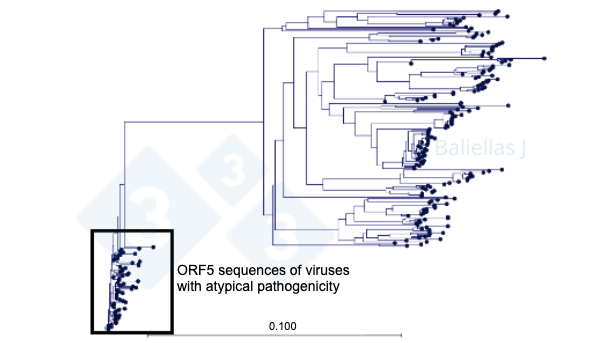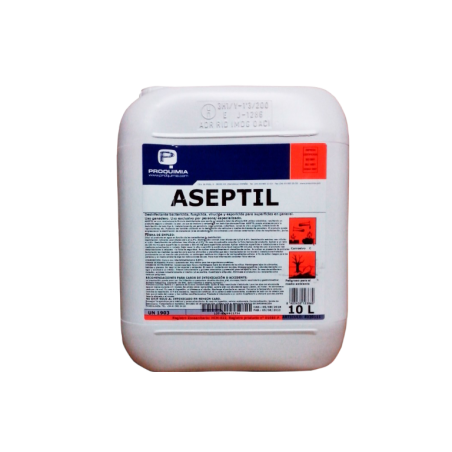Porcine reproductive and respiratory syndrome virus (PRRS) is characterized by high genetic and antigenic variability depending on the virus isolate, causing a variable economic impact depending on the disease it generates on the farm. According to a study by Nathues et al. (2017) the cost of a PRRS outbreak on a farrow to finish farm can range from €101 to €650 per sow per year.
Pathogenic effects of atypical PRRS

For years, highly virulent outbreaks have been attributed to PRRS viruses with atypical pathogenicity. In general, genotype 1 is the most frequent genotype in European countries. Genotype 1 is associated with less virulent outbreaks, mainly because it generates fewer systemic and respiratory symptoms than genotype 2, which is the predominant genotype in America and Asia. In 2001, a highly virulent strain was detected in the state of Minnesota and named MN184. This strain was later linked to Canadian strains according to a study by Shi et al. (2010). In 2006, a highly virulent strain was detected in China and spread to dozens of provinces within a few months. The outbreaks it caused on farms in some cases led to abortion rates above 40%. On the European continent, in 2007 the Lena strain (genotype 1 and subtype 3) was isolated on a Belarusian farm that presented reproductive problems and high mortality, in some cases exceeding 70% in finishing animals. In a nursery in Italy in 2014, a strain was detected that was typed as highly pathogenic with the name PR40 which was characterized by high mortality (up to 50%).
The origin of these strains
The mechanisms from which these PRRS virus strains originate are not exactly known. There are several hypotheses; one of the possible causes of the appearance of these viruses would be the genetic variations that occur in the initial viral genome. In scientific studies such as the 2006 Chinese strain study, deletions were detected in the Nsp2 region, which were even used as a marker to distinguish this highly pathogenic strain. In the Lena strain they detected a smaller N protein and a larger GP4 protein.
Mode of action of highly virulent strains
In regard to the pathogenic action of these strains, Cho et al. (2007) found that by inoculating with a highly virulent PRRS virus genotype 2 strain (MN-184), the viral loads in the infected pigs were significantly higher in tonsils and sera compared to a low virulence strain. In other studies by Frydas et al. (2013, 2015, 2018), aerosols remained with a detectable virus presence for a longer period of time.
Characteristics of highly virulent strains compared to the rest:
- Cause more damage, more quickly
- Attack the lungs and other tissues of the lymphatic system such as the thymus or bone marrow.
- Prolonged fever (>41°C), decreased average daily gain, higher mortality, and higher viremia
- Increased atrophy of the thymus
In some studies with highly virulent strains, high levels of IL-10 were detected in the early stages of infection that could increase virus survival and delay the onset of protective immunity, and low levels of IL-4 hinder the immune response of the animals. Carnelli et al. (2017) compared a highly virulent Italian strain (PR-40) with another strain considered to be of low virulence, observing that the neutralizing antibody response was also lower. Gimeno et al. (2011) established a relationship between TNF- α induction of PRRS strains with their degree of virulence.
Highly virulent PRRS virus strains cause more accentuated clinical symptoms in pigs, higher mortality, higher viral load and dissemination in body tissues, a greater inflammatory response, and in some cases the immune response developed by the animal is less effective.
Epidemiological implications
At the regional PRRS control level, the presence of some highly pathogenic strains that generate higher viral loads and greater excretion can hinder virus containment and increase the risk of spread to other farms. The intensification of all external biosecurity measures and ensuring the optimal immune status of the pigs present on the farms of a region are useful tools to prevent the rapid spread and avoid the heavy economic losses they cause.
The increase in the "globalization" of animal movements, in terms of importing piglets, replacement breeding animals, and pigs for slaughter, increases the probability of strains entering that are different from the typical ones in a region, which can imply a greater challenge to the immune system. Sharing information on outbreaks and sequences in a region makes it possible to establish the possible presence of highly virulent strains and try to reduce their spread. For example, Figure 1 shows a phylogenetic tree with the history of ORF5 sequences detected in a region over a period of 4 years and the location in the phylogenetic tree of the sequences of a strain of atypical pathogenicity widely disseminated in that same region in a short period of time. In this way, the ORF5 sequence of the strain present on a farm with a clinical outbreak can help us to predict if it is a PRRS virus with atypical pathogenicity.
The complexity of PRRS virus disease control increases when we encounter situations where the effects are caused by a highly virulent strain. Improving and maintaining a high level of biosecurity and an optimal immune status are measures that will help us to mitigate the effects of this type of strains.










